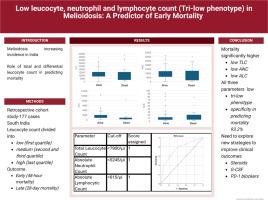Low leucocyte, neutrophil and lymphocyte count (tri-low phenotype) in melioidosis: A predictor of early mortality
IF 4.8
Q1 MICROBIOLOGY
引用次数: 0
Abstract
Introduction
Melioidosis is a bacterial disease caused by Burkholderia pseudomallei, a gram-negative bacillus endemic to parts of Asia and Northern Australia. This study aimed to identify the role of total and differential leucocyte count in predicting 48-h mortality in patients with melioidosis.
Methodology
This retrospective cohort study included patients diagnosed with culture-proven melioidosis at Kasturba Medical College between 2017 and 2023. Total leucocyte count (TLC), absolute neutrophil count (ANC), and absolute lymphocytic count (ALC) were classified into low (first quartile), medium (second and third quartile) and high (last quartile). The chi-square test was used to compare each group's early (48-h) mortality.
Results
Of the 170 patients with culture-confirmed melioidosis, 24 patients died within 48 h. The mortality was significantly higher in those with low TLC, ANC and ALC. When all three parameters were found to be low (tri-low phenotype), the specificity in predicting mortality was 93.2 %.
Conclusion
Low TLC, ANC and ALC are significant predictors of mortality among melioidosis patients. There is a need to explore new strategies to improve clinical outcomes among melioidosis patients with tri-low phenotype.

瓜虫病中的低白细胞、中性粒细胞和淋巴细胞计数(三低表型):早期死亡率的预测因素
导言:美拉菌病是由假马来伯克霍尔德氏菌(Burkholderia pseudomallei)引起的一种细菌性疾病,这是一种流行于亚洲部分地区和澳大利亚北部的革兰氏阴性杆菌。本研究旨在确定总白细胞计数和差异白细胞计数在预测美拉德氏病患者 48 小时死亡率中的作用。白细胞总数(TLC)、绝对中性粒细胞计数(ANC)和绝对淋巴细胞计数(ALC)被分为低(第一四分位数)、中(第二和第三四分位数)和高(最后四分位数)。结果 在170名经培养确诊的类鼻疽患者中,有24名患者在48小时内死亡,低TLC、ANC和ALC患者的死亡率明显较高。结论TLC、ANC和ALC偏低是预测瓜虫病患者死亡率的重要指标。有必要探索新的策略,以改善三低表型类鼻疽患者的临床预后。
本文章由计算机程序翻译,如有差异,请以英文原文为准。
求助全文
约1分钟内获得全文
求助全文
来源期刊

Current Research in Microbial Sciences
Immunology and Microbiology-Immunology and Microbiology (miscellaneous)
CiteScore
7.90
自引率
0.00%
发文量
81
审稿时长
66 days
 求助内容:
求助内容: 应助结果提醒方式:
应助结果提醒方式:


